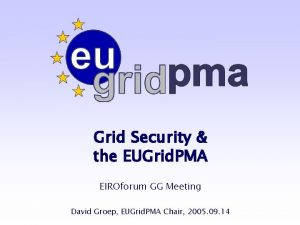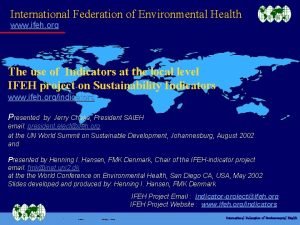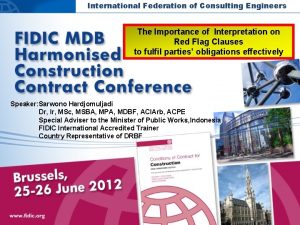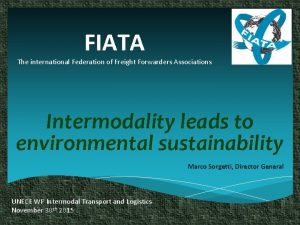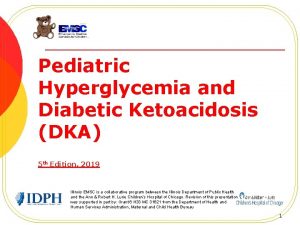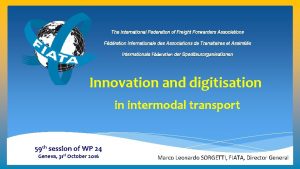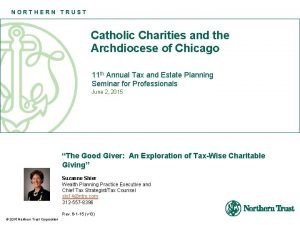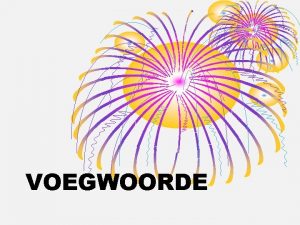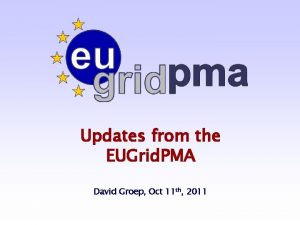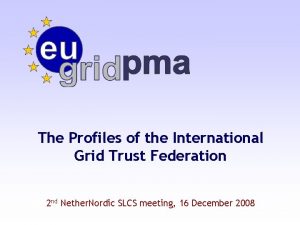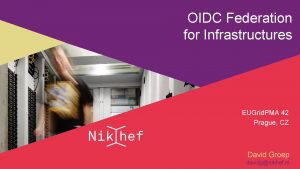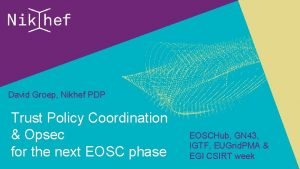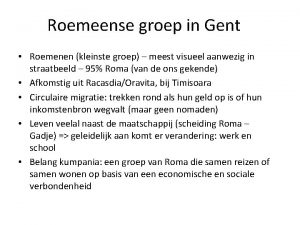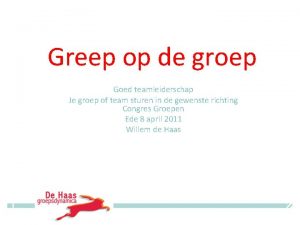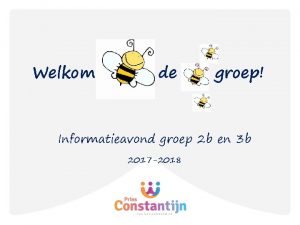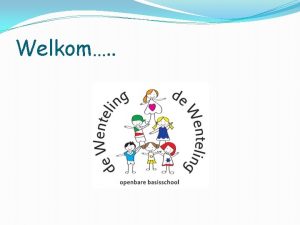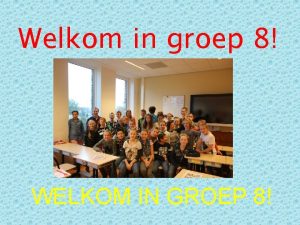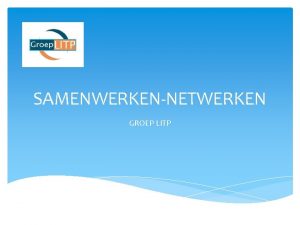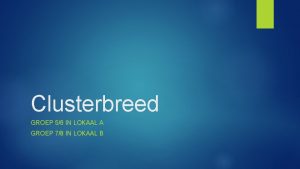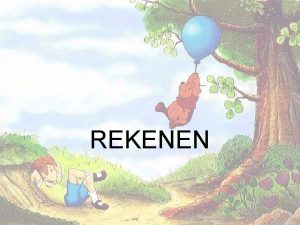The International Grid Trust Federation David Groep EUGrid





















- Slides: 21

The International Grid Trust Federation David Groep EUGrid. PMA also supported by EGI. eu EGI-In. SPIRE RI-261323, and Bi. G Grid, the Dutch e. Science Grid enabling an interoperable global trust fabric

The Need for a Global Trust Fabric More than one administrative organisation More than one service provider participates in a single transaction More than one user in a single transaction More than one authority influences effective policy Single interoperating instance at the global level 2011 -06 -10 International Grid Trust Federation 2005 - 2011

Overlapping Communities – Common Trust Reduce over-all policy burden by adhering to common criteria Goals • allow multiple sources of authority: User, Institute, Community • acknowledge both long- and short-term community structures • enable security incident response and containment • balance data protection and right to privacy to provide basis for access control decisions by resources and communities 2011 -06 -10 International Grid Trust Federation 2005 - 2011

Attributes and Access Control Several communities have complementary information for a user Access control based on policy expressed in these attributes, including the ID • attributes will need to be linked • link identifier to provide persistency 2011 -06 -10 International Grid Trust Federation 2005 - 2011

Requirements on a trusted source Privacy and data protection Access Control Attribute handle • unique binding • never re-assigned • important ‘unalienable right’ for research • correlation of PII among service providers could allow profiling • exchange of PII often fraught with issues Measurement and Accounting • publication metrics • usage metering, billing • auditing and compliance monitoring Incident Response • long-term* traceable • independent from short-lived community • must be revocable • correlate with other information sources • banning and containment handle 2011 -06 -10 A common ID must live in a policy ecosystem to protect participants and to limit its use to specific purposes International Grid Trust Federation 2005 - 2011

Elements of Trusted Identity 1. Vetting and assurance – for identity and attributes – vetting rules and data quality – expiration and renewal – revocation and incident containment 2. Operational requirements for identity providers – operating environment and site security – staff qualification and control 3. Publication and audits – openness of policy, practices and meta-data – review and auditing 4. Privacy and confidentiality guarantees 5. Compromise, disaster recovery and business continuity 2011 -06 -10 International Grid Trust Federation 2005 - 2011 OGF CAOPS-WG: Authentication Profile Structure, WG draft

Assurance levels Trust in the assertions by resource and service providers is key • Until now, our e-Infrastructure used a single ‘level’ – there are well-known ‘government’ standards for Lo. A (US: OMB M-04 -04 & NIST SP 800 -63) – but 95/46/EC and 1999/93/EC are not of much use to us and the Nice treaty states that identity is a national matter … – there is rough but not 1: 1 correspondence between balanced needs of the providers and users and the NIST Lo. A levels 2011 -06 -10 International Grid Trust Federation 2005 - 2011

IGTF Assurance Levels Type and classification of e-Infrastructure services drives the level of assurance required • Security and assurance level set to be commensurate – not overly high for ‘commodity’ resources – not too low, as providers otherwise start implementing additional controls on top of and over the common criteria – defined in collaboration with resource providers – using transparency and a peer review processes – leveraging our own community organisation mechanisms 2011 -06 -10 International Grid Trust Federation 2005 - 2011

Establishing the IGTF – EU AP TAG • EU Data. Grid established Coordination Group in 2000 • Global need resulted in the 2003 Tokyo Accord • With start of production e-Infrastructures – EUGrid. PMA established with DEISA, EGEE, SEE-GRID, and TERENA (TACAR) as relying parties and national identity providers in 2004, with e-IRG endorsement – APGrid and PRAGMA establish the APGrid. PMA – Canada, EELA-countries and USA Id. Ps establish TAGPMA • Consistent guidelines and service provider involvement 2011 -06 -10 International Grid Trust Federation 2005 - 2011

Global Trust 86 accredited authorities from 53 countries and economic regions

Structure of Trust • Common criteria and model – globally unique and persistent identifier provisioning – not fully normative, but based on minimum requirements • Trust is technology agnostic technology and assurance ‘profiles’ in the same trust fabric ‘classic’ traditional public key infrastructure ‘MICS’ dynamic ID provisioning leveraging federations ‘SLCS’ on-demand short-lived token generation a basis for ‘arbitrary token’ services – new profiles – – 2011 -06 -10 International Grid Trust Federation 2005 - 2011

IGTF Common Criteria 2011 -06 -10 International Grid Trust Federation 2005 - 2011

Assurance levels in the IGTF Technical and operational controls • Authorities come in two basic flavours – off-line (only used in ‘traditional’ PKI): human controls and air-gap security provide protection against attacks – on-line infrastructure (federation-backed, SLCS and classic): valuable security material is network connected need compensatory controls: • secure hardware, compliant to FIPS 140 -2 level 3 • additional layered network security • Technical requirements apply to any attribute source – such as community registries like ‘VOMS’ 2011 -06 -10 International Grid Trust Federation 2005 - 2011

Vetting Assurance Levels Identity controls and vetting • long-term traceable assurance (classic, MICS) – based on in-person checking of (nationally defined) official identity documents – recorded identity persists beyond the moment of issuance – assertions can live for a long time (over a year) to facilitate longterm use – but compromise may happen, so is revocable • momentary assurance (SLCS) – traceability to a physical person for at least one year – may use any vetting mechanism that assures that traceability – but assertions are limited in time to 24 hours (unless revocable, in which case: 11 days) https: //www. eugridpma. org/guidelines/{classic, mics, slcs} 2011 -06 -10 International Grid Trust Federation 2005 - 2011

Building trust – an exercise in scaling • Accreditation process – – Extensively documented public practices (CP/CPS, RFC 3647) Interviewing and scrutiny by peer group (the PMA) Assessment against the Authentication Profiles Technical compliance checks (RFC 5280 and GFD. 125) • Periodic, peer-reviewed, self-audits – Based on Authentication Profiles, standard reference: GFD. 169 – OGF & IGTF, inspired by NIST SP 800 -53/ISO: IEC 27002 • Federated assessment methodology by region (IGTF) https: //www. eugridpma. org/guidelines/accreditation 2011 -06 -10 International Grid Trust Federation 2005 - 2011

Federated Identity in Europe Today Map colour coding Green: classic accredited authority Blue: classic + federated authority Yellow: pending classic accreditation Federated ‘translating’ authorities: integrity requirements propagate to all data sources e. g. TERENA Certificate Service qualifying Federations Id. Ps meet all IGTF requirements and TCS provides instant access to globally trusted identities Also in Australia: ARCS SLCS, in USA: CILogon 2011 -06 -10 International Grid Trust Federation 2005 - 2011

Beyond identity • Many attributes come in to an authorization decision – identity, community, group membership, roles, position, . . . – the ‘other attributes’ are important for contextual control and thus of importance beyond only resource providers • Operational requirements translate easily to any kind of attribute source • Operational and assurance requirements apply where assertions are bridged such as in the STS 2011 -06 -10 International Grid Trust Federation 2005 - 2011

Carrying assertions across domains Service access crosses technology and domain boundaries and may need translating in a Security Token Service (STS) – trust relationship – operational requirements STS examples: GEMBus, EMI-STS, . . . Requirements on • assurance level • operational security • auditing, data protection and transparency of process all remain GEMBus image by Diego Lopez, Red. IRIS and GEANT, 22 nd EUGrid. PMA meeting EMI STS image by Christoph Witzig, SWITCH and EMI, 22 nd EUGrid. PMA meeting 2011 -06 -10 International Grid Trust Federation 2005 - 2011

Common Criteria and Diversity • Up till now. . . – providers of compute and storage services in e-Infra able to agree single ‘least common denominator’ – many content-only (web site) providers could live with lower assurance and asked no real Lo. A requirements . . . but this may be changing • more diverse content and services being offered – via many mechanisms, both web and non-web – may need diversifying not only technology, but also Lo. A 2011 -06 -10 International Grid Trust Federation 2005 - 2011

So why IGTF? • Trust is technology independent • Agreeing on common minimum requirements on global scale – facilitates interoperation across infrastructures – significantly reduces potential for failures and obstacles for interop • Participative model, including major relying parties and national representatives, ensures commensurate security level – the single assurance level is convenient, but the world will likely diversify – the IGTF assurance levels will follow and adapt as a result – as well as expand to address changing technologies Defining assurance requirements need strong involvement by relying parties, resource providers and users

International Grid Trust Federation – http: //www. igtf. net/ EUGrid. PMA European Policy Management Authority for grid authentication in e-Science – https: //www. eugridpma. org/ International Grid Trust Federation 2005 - 2011
 Eugrid
Eugrid Eugrid
Eugrid International federation of environmental health
International federation of environmental health Occurenced
Occurenced International federation of nurse anesthetists
International federation of nurse anesthetists International federation of freight forwarders associations
International federation of freight forwarders associations Interreligious and international federation for world peace
Interreligious and international federation for world peace Pgcs score
Pgcs score International federation of freight forwarders associations
International federation of freight forwarders associations Ifpma code
Ifpma code Northern trust charitable trust
Northern trust charitable trust Pin grid array and land grid array
Pin grid array and land grid array Hát kết hợp bộ gõ cơ thể
Hát kết hợp bộ gõ cơ thể Slidetodoc
Slidetodoc Bổ thể
Bổ thể Tỉ lệ cơ thể trẻ em
Tỉ lệ cơ thể trẻ em Gấu đi như thế nào
Gấu đi như thế nào Tư thế worm breton
Tư thế worm breton Chúa yêu trần thế
Chúa yêu trần thế Các môn thể thao bắt đầu bằng từ đua
Các môn thể thao bắt đầu bằng từ đua Thế nào là hệ số cao nhất
Thế nào là hệ số cao nhất Các châu lục và đại dương trên thế giới
Các châu lục và đại dương trên thế giới

